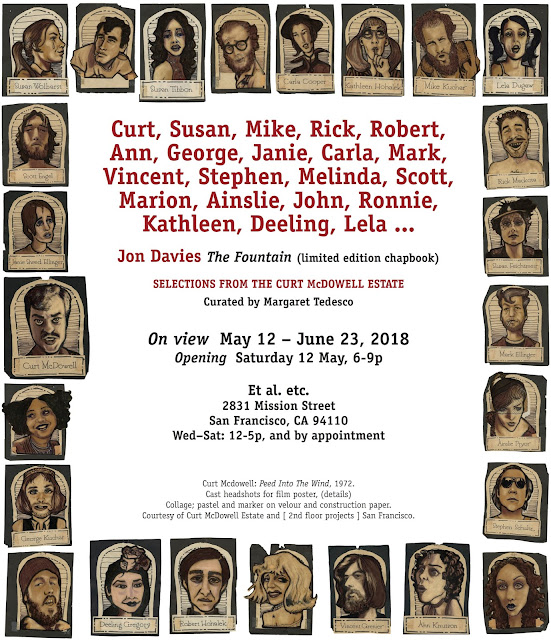CURT McDOWELL :: JON DAVIES
“Get out of my way, Mom! I’m going to San Francisco to find out who and what I am! Don’t try to stop me!”
—From Buzzy (California or Bust), Zip-A-Tone comic strip panel, 1975.
SELECTIONS FROM THE CURT McDOWELL ESTATE
The prolific output of director, writer, actor, and artist Curt McDowell began in high school in Lafayette, Indiana. In the mid-60s he moved to San Francisco to study painting at the San Francisco Art Institute, but soon decided to transfer to the film department to mentor with the recently-relocated George Kuchar, who became lover, friend, and collaborator. Robert Evans, another friend and eventual partner to McDowell was co-owner of The Roxie Theater, which in 1976 was established as an art and independent film house. McDowell became a cinematic staple on the scene from the early 1970s until his death due to AIDS complications in 1987.Curt was constantly drawing, always had a notebook on hand, says the late George Kuchar & his brother Mike; in between his cinematic making (which includes over 35 films), McDowell produced a staggering number of drawings, photo collages, watercolors, posters for films, diorama style film sets, and elaborate Zip-A-Tone comics—all storyboards of sorts—the byproduct of regularly held Tuesday night art parties with The Roxie Theater family of friends. Reflecting the candor of McDowell’s sexual films, this graphic output captures the intimacy of his ever evolving and deeply rooted social circle in what would be a secondary and yet immediate practice.
Curt also left us forty impeccable diaries—detailed accounts describing his works, conversations, moods, lovers, and friends—a kind of extended self-portrait, along with numerous scrapbooks documenting his times. These materials provide a telling glimpse into the lives of artists lost to us at a point of tumult or liberation during key points of queer history. The timespan witnessed queer people mobilizing from the Gay Liberation Movement to HIV/AIDS activist communities reflecting regional subsects of queer life linked to their period of artistic production. And from this private, radical urgency, an aesthetic emerged that can be located in contemporary practitioners today. But these objects must not remain hidden in the cabinets or the drawers of those who remain.
Peed Into The Wind, 1972. Cast headshots for film poster, (details). Collage; pastel and ink on velour and construction paper. Courtesy of Curt McDowell Estate.
![[ 2nd floor projects ]](https://blogger.googleusercontent.com/img/b/R29vZ2xl/AVvXsEi6OCE5ksNHOdbBt5OWlqbfGwv8KbvAzO6Bsv11YCxq_8Ner8TzGgijIbTj2dSpdlkRK2tErQMXtWSMLZ_OjJfdVRRrOgGVRcEI3ycixOq889rTbma7JYkeTka6p7nNNY3nsR8lQLZ1YX4/s1600/2nd+floor+projects+logo.jpg)

Comments